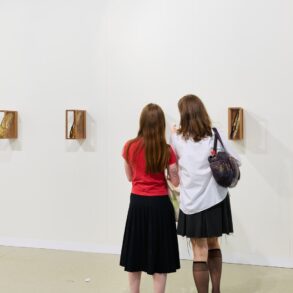Until the 1960s, the word computer indicated a worker—often a woman—who entered calculations into a mainframe. An exhibition now at MUDAM in Luxembourg and traveling to Kunsthalle Vienna, “Radical Software: Women, Art & Computing 1960–1991,” unearths the history of this gendered workforce, while also highlighting those women artists experimenting with or “musing” those same machines. Taking a broad view of the computer in art history, it includes artists who used the computer as tool and as subject, as well as those who simply “worked in a computational way.”
The exhibition is divided into five thematic sections, organized roughly chronologically. “Zeros and Ones” shows early experiments in computing, mostly in the form of wall-based works, but it also includes Liliane Lijn’s kinetic sculpture Man Is Naked (1965), a fragile work from her “Poem Machines” (1962–68)series rarely seen in operation. In the “Hardware” section, paintings by Ulla Wiggen and Deborah Remington evoke the mysteries of various technologies hidden behind their shiny exteriors, while “Software” returns to weaving as the origins of the “soft wares” that have come to define computational output. “Home Computing” traces the availability of the computer to artists who were making screen-based works via novel programs. And finally, “I would rather be a cyborg than a goddess,” which takes its name from Donna Haraway’s 1985 “Cyborg Manifesto,” explores the repercussions of the computer on the (female) body, via the likes of Valie Export’s photomontages and Analívia Cordeiro’s algorithmic choreographies.
The show is organized around a technology rather than a genre, movement, or medium, which makes for unexpected and captivating inclusions. A computational rendering of Isa Genzken’s Ellipsoid (1977), for instance, is displayed alongside the sculptural object that it produced. The pairing underscored her ambition to make sculptures she called “mathematically correct.” Elsewhere, The House of Dust (1967), a computer-generated poem by Fluxus artist Alison Knowles, is displayed on a vintage printer, alongside Katalin Ladik’s Genesis 01-11 (1975), comprising enchanting sonic interpretations of various circuit boards rapidly obsoleting.

Charlotte Johannesson: Untitled (detail), 1981–85.
Courtesy of the artist and Hollybush Gardens, London
Some of these early experiments betray an uncertainty about the status of “artwork.” Beryl Korot—cofounder of the magazine Radical Software, from which this exhibition takes its title—displays Text and Commentary (1976–77) as sketches, woven textiles, and videos, alongside documentation of the process. It is unclear where the art object ends and the idea begins, a move in line with the conceptual art movement of the time.
The exhibition positions the advent of computing as a process that eradicates any separation between fine art and craft. This rupture is welcome, as women have historically been excluded from the former category. This argument is most clearly articulated in the links the exhibition makes between computing and weaving: digital artist Charlotte Johannesson, whose work is shown as woven fabrics, digital drawings, and digital images displayed on impressive LCD screens in the sculpture garden, asserts that the screen’s pixels correspond to the warps and wefts of the loom.
But the exhibition here misses an opportunity to thread a more expansive history of the relationships between weaving and computing, overlooking Indigenous women’s efforts in particular. There are no indigenous weavers, nor does the exhibition feature any reference to the weaver women who produced Intel microchips on the Navajo reservation, a story that has been recounted in the art world at least since the inclusion of Marilou Schultz at Documenta 14 in 2017.

Samia Halaby: Bird Dog 6, 1987.
Courtesy of the artist and Sfeir-Semler Gallery Beirut/Hamburg
Computing is infrastructurally intensive, and “Radical Software” traces how artists took up computing in ways defined by the limited access to these technologies. The show lays claim to a global perspective that it ultimately doesn’t flush out: there are more artists named Barbara here than artists based in the Global South.
A timeline, included in the booklet and exhibition catalog, tracks women’s contributions to computer history. It spans the first use of the term “computer” in 1613 to the public availability of the internet in 1991. It merges hallmark moments by figures such as Ada Lovelace, the NACA computers, the ENIAC six, and Grace Hopper with the history of women artists concerned with the digital realm. In doing this, the exhibition aligns its artists with women working for the military-industrial complex: ENIAC, the world’s first modern computer, was invented to compute ballistic missile trajectories (six young women programmed it), and Grace Hopper was a Navy officer. No computer program initiated by the United States government during the Cold War can be separated from its military efforts.
The exhibition revitalizes women who developed lethal tech, and whose stories deserve a dose of scrutiny, alongside those who expended great effort to experiment toward a more equal world. The question is whether this shared narrative serves these artists, whose experiments with the machines are described in the exhibition materials as comprising “the history of misuse.” There is no need to girlboss ballistics.

Dara Birnbaum: Pop-Pop Video: Kojak/Wang, 1980.
© Dara Birnbaum. Courtesy Electronic Arts Intermix (EAI), New Yor
The exhibition realizes its fullest potential when it showcases artists’ experimental brushes with a new toolbox. Barbara T. Smith’s Outside Chance (1975) uses 3,000 computer-generated “snowflakes” that she threw out a Las Vegas hotel room window to combine the best of programming with conceptual performance. Dominique Gonzalez-Foerster’s work on Ada Lovelace, expressed in the computer language ADA, proves a heartfelt biography in code. Samia Halaby’s kinetic paintings and soundscapes, for which she learned BASIC and C coding languages, are a real addition to the field of abstract painting.
“Radical Software” makes for compelling new art historical readings through the means of computational technology. But as we are grappling with the impact of 20th-century technological developments in every realm, be it social, artistic, or military, inserting artists alongside engineers working toward military ends is a betrayal to the utopian thinking so ubiquitously felt in the show’s best pieces. “Radical Software” shows that much remains to be done to properly recognize the women who were computers’ developing workforce, problematic pioneers, and experimental misusers.
This post was originally published on this site be sure to check out more of their content







